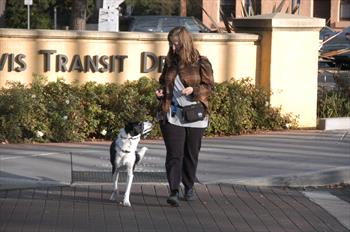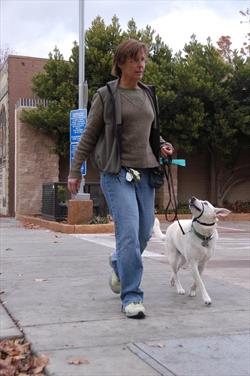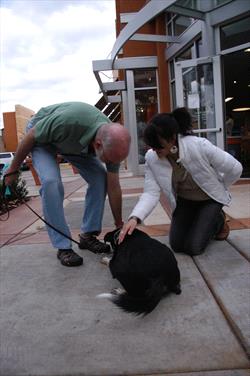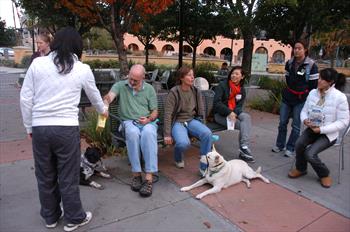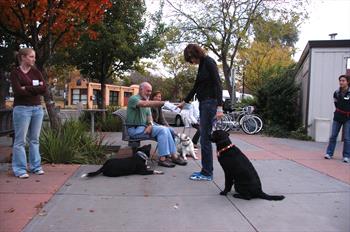
I remember in high school math class thinking, math wouldn’t be so bad if it weren’t for the word problems. Now, as an adult, I think, if you can’t do the word problems, which represent math in real life, you don’t really know math. Similarly, with dog training classes, it’s great when dogs know how to sit, and heel and focus on their owners in the controlled class environment but what they really need is to be able to do those things in real world. That is, it’s not good enough to do them just at their home or in their own neighborhood, the behaviors must be reliable in new locations with high distractions. That is why I frequently have a field trip after the last week of a 6-week dog training session. And that’s what we did today. We took a field trip to downtown Davis. Four dogs-five if you include my dog Jonesy-attended. Four had a history of lunging at, snapping at unfamiliar dogs, one had a history of lunging or snapping at people in his personal space. These were all issues we had addressed in behavior consults for some dogs as well as during this class. And then there’s Jonesy. In unskilled hands he’s more likely to bark fearfully at skateboards, loiters, and random objects and then become overly aroused. Here are the exercises they worked on today.
Exercise 1: Sit at corners and heel across the street
It’s difficult to look both ways for cars when waiting at the corner if your dog’s dragging you around or getting ready to trip you. In exercise one, all dogs were required to sit at the each corner and heel when going across the street. Remember, if you need to watch your dog when crossing the street, make sure there are no careless drivers or bike riders who could accidentally run you over.
Exercise 2: Walking at attention past people
When out walking, it’s important for dog and handler to share the road with pedestrians. Many people are uncomfortable with unfamiliar dogs regardless of whether the dog is friendly or not. So in these exercises dog owners were required to 1) keep their dog close enough to them so that pedestrians would not feel like they had to move out of the way. 2) Keep their dog looking at them as pedestrians passed if there was any chance their dog might look at or try to sniff the pedestrian. While looking at pedestrians may be ok, it’s nice for people to know for sure that you have control of your dog. Owners could also just move off to the side and have their dogs perform sits facing them and away from those passing by.
Exercise 3: Defensive greetings
Next we set two student volunteers up on the sidewalk to act as dopey dog greeters. As dogs walked down the sidewalk, the volunteer inappropriately approached to pet the dogs and possibly solicit jumping while stating, “Can I pet your dog?” Dog owners defensively backed up with their dogs so that it was clear that the answer was “not yet.” Once they had their dogs sitting, or lying down, they invited the greeters to greet. For the dog in the class who was fearful of unfamiliar people, the owner worked on keeping the dog focused and out of trouble.
Exercise 4: Walking next to other dogs
Now dogs were required to walk down the sidewalk in tandem. This was probably the most difficult exercise. Dog tended to sneak glances away in between heeling at attention. Jonesy gave several student volunteers a workout. He looks easy because he’s fairly well behaved for me. When other people work with him they he’s probably more difficult than any dog they will handle. They learn that they will be doing lots of running around, with fast paced changes in order to keep his attention. Look away for instant and he’s getting into trouble.
Exercise 5: Clearing the sidewalk to let others pass by
Here everyone clears the sidewalk to let people pass by. Then owners keep their dogs focused on them even when student volunteer pedestrians try to distract them.
Exercise 6: Chilling out on downtown benches
Sometimes you want to just sit with your dog and enjoy the scenery, your meal, or conversing with friend. In this exercise, dogs were required to lie down while owners sat on downtown benches. Then student volunteers as well as dog owners took turns walking up to the handlers with dogs and offered human food. The dogs were required to remain sitting or lying down and were not allowed to sniff the other dog.


